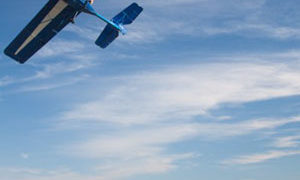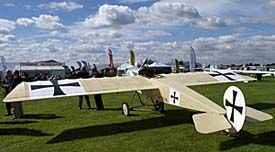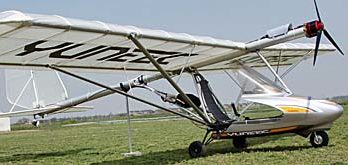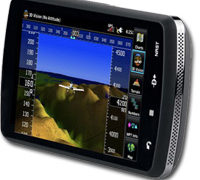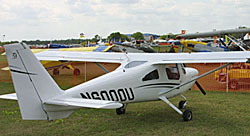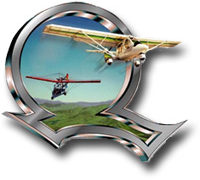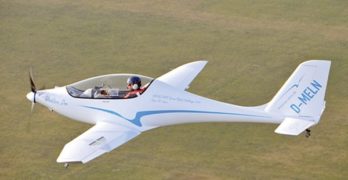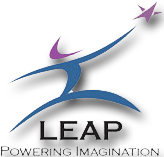Last Spring I had the pleasure of photographing the several aircraft that make up the stable of the re-emergent Quicksilver Aeronautics company. Quicksilver is the once-and-future, Cessna-style flagship of the ultralight industry back in the 70s and 80s, when it sold almost 15,000 single seater and two-seat aircraft kits under the FAA Part 103 regulation.
What always blew me away about Quicks, beyond their easy-to-fly, docile performance and truly bugs-in-teeth fun personality was the impeccability of the kits themselves. I haven’t seen one in years, but according to people I’ve talked to, they’re even better than they were back then…and that’s saying something! Quicksilver kits were the epitome of how a kit should be produced for sale. If you ever put together a Revell plastic model then you’ve got some idea of how a Quick kit arrives. All the anodized aluminum structural tubes for example are predrilled, immaculately finished and vacuum shrink-wrapped onto large printed cardboard sheets that individually identify every piece right where it’s “mounted” onto the sheet.
Search Results for : Part 103
Not finding exactly what you expected? Try our advanced search option.
Select a manufacturer to go straight to all our content about that manufacturer.
Select an aircraft model to go straight to all our content about that model.
Sunny Skies for England’s LAA Rally
Our roving British journalist, the always-entertaining Dave Unwin, reports on the UK’s LAA Rally event, giving ByDanJohnson.com readers a taste of light aviation in England.
After an even grimmer British summer than usual — we’ve just experienced the “wettest drought” since records began; a dry spring followed by flooding rains — the weather Gods smiled benignly on the 2012 LAA Rally. The Rally is basically the UK’s version of Oshkosh (albeit several orders of magnitude smaller) and is run by the Light Aircraft Association, formerly the PFA or Popular Flying Association, which is the Limey equivalent of the EAA. The event has been staged at several different airfields over the years, and is currently held at Sywell in Northamptonshire.
Despite the parlous state of the economy, this year’s Rally had a real buzz, and it wasn’t just all the two-stroke engines. In spite of EASA’s best efforts it would seem that the lighter side of UK aviation continues to thrive.
Electric! Gorgeous! Freedom! …4th Generation ULS
Randall Fishman virtually invented the electric aircraft. That’s a rather big statement yet I stand behind it. Randall first showed a functional electric trike at Oshkosh 2007. He’s been on a tear ever since and his ULS is his present state-of-the-art, his fourth generation of electric aircraft design.
*** I use three words to describe ULS deliberately. It’s electric. That’s obvious but singular. Fishman’s Electric Aircraft Corporation is presently selling electric powered aircraft. You can also buy an electric eSpyder from Yuneec or an eGull from Earthstar but after that, mostly what you hear about electric aircraft are developments… fascinating but just developments. Electric Aircraft Corporation is ready today.
*** ULS is gorgeous. You can see that for yourself and I have to presume you agree because it is simply beautiful in its sweeping lines, slippery smoothness, and overall elegance. It wowed visitors to Oshkosh 2012 and it’ll do that at any airport I submit.
LSA & Lightplane Highlights at Oshkosh 2012
In the near future, we’ll present fuller stories of some of the following short bits from Oshkosh 2012. With UltralightMews, we shot videos on most of the following, too, so watch for those as we can post them. Enjoy!
CESSNA & PRIMARY CATEGORY Early on in the week, Cessna announced they would transition their LSA Skycatcher to Primary Aircraft status. That requires a Type Certificate and FAA production approval but the Wichita giant can do this handily even if will add some cost. More on in a later article. However, here’s a way Cessna can recapture some 80 orders from Europeans cancelled earlier this year. On a more fun note, it was a pleasure to meet all nine of their youthful ambassadors that worked in the Discover Flying Challenge program. We shot a video featuring each participant and we’ll post that as soon as possible. (In the near future, we’ll feature a brief review of Primary Category versus LSA.)
AHOY, AKOYA!
Aero 2012 — One More Thing…
Aero 2012 is one of those shows that has interesting aircraft in more nooks and crannies than even a crack reporter like Dave Unwin can find. Thanks to Tom Peghiny (of Flightstar eSpyder, and Flight Design USA fame), we have more from the German show. —DJ ||||
At Apple press events, the late Steve Jobs would often tease the crowd with “one more thing.” Here’s the ByDanJohnson.com equivalent from Aero…
*** Enthusiasts of electric aircraft realize that the road to electric-powered, general-use aircraft is still off in the future. For example, we haven’t seen much lately about the electric Cessna 172 project. One thing seems certain: the first electric airplanes to find market success will surely be the lightest of the breed. *** Tom Peghiny sold his Flightstar designs to electric aircraft developer, Yuneec so they could advance the eSpyder. Tom confirmed Yuneec is hard at work and that we’ll see the eSpyder as an LSA in America but first it will appear as a German ultralight.
Aero 2012: Day 4 — Engines & More Aircraft!
Aero 2012 concluded and we present a final round of aircraft news to be followed by a wrap up view. All photos by Dave Unwin —DJ ||||
LSA SUPPLIERS & ENGINES
Garmin had a pretty big presence at the show. I spoke to Matt Harran who told me that the newest items Garmin had at Aero 2012 are improved VFR charting for the GPSMAP 795, which includes more specific data from Jeppesen, which can be uploaded onto the unit.
*** Along with the usual two and four-strokes there were some diesels, a hybrid and a couple of rotaries at Aero 2012. More esoterically, there were also some small jets and turboprops, and several electric motors.
••• An Italian company, MW Fly, also had three versions of its B22 on show; the 95 horsepower 22D, 115 horsepower 22L and 130 horsepower 22R. These geared, liquid-cooled flat-fours feature electronic ignition and injection.
••• Although not the usual ByDanJohnson content, Diamond’s DA-52 VII deserves a mention because the new aircraft generated a great deal of interest.
LSA Highlights from Sun ‘n Fun 2012
Whew! It’s over. Man, Sun ‘n Fun can be the busiest six days of one’s life… well, at least until the next one. In this survey article, I want to skim the very top of what I found interesting at the recently concluded show. Each highlight will get fuller coverage. Before starting, though, I owe a couple shout-outs. *** A huge, enormous thanks to Jim Lawrence who kept you up on a daily basis. Accomplishing that means long days shooting photos, interviewing personalities, and working into the night in a motel room with a crappy Internet connection. It may look easy and fun but only half that assessment is true (hint: it ain’t easy). *** Secondly, another thanks-a-million to UltralightNews, my video collaborator. I have the easy job; they will put in an enormous number of hours to edit and finish more than two dozen new videos that I’ll post here as each is done.
Kodak Moment for Quicksilver Aeronautics
Among all aircraft producers in the world, a very limited number have exceeded the daunting barrier of delivering more than 10,000 airplanes. Those in this exclusive club include manufacturers of major aircraft such as Boeing, Cessna, Piper and precious few others. While Van’s Aircraft is approaching this number with their RV kit-built aircraft series (itself a rather incredible achievement), no recreational aircraft company has passed the 10,000 unit mark… except one: Quicksilver. *** For many pilots Quicksilver makes “ultralights.” Indeed they do, in that some models can be built to stay within FAA’s Part 103 rule. Quicksilver also makes two seaters in two model lines — the MX series and the GT series — and those are now considered Experimental Amateur-Built aircraft. Except for dealer-built Part 103 Quicksilver aircraft, er… “ultralight vehicles” to use the preferred FAA term, all the California company’s aircraft have been constructed from kits.
Electric-Powered Light Aircraft
Flying with Juice
As an airplane approaches, a whirring sound accompanied by a
barely discernible whine and a mild propeller buzz exhibit a
Doppler effect as the plane passes overhead. What is that curious noise?
We are intimately attuned to internal combustion engine sounds –
some experts claim they can identify the brand and size of an engine
simply by listening to it run. We’re less aware of electric motor noises
because we quickly tune them out. Electric motors run everywhere in
our lives – in our refrigerators, our computers, in our ceiling fans, and
numerous other appliances. Most motors – it’s incorrect to call them an
“engine” – are exceptionally quiet, and that’s a good thing.
One wonders if relatively quiet electric motors on aircraft will invade
our piston-powered world, especially given noise sensitivity at many airports.
Some say, “We’re about to see if electric works.” I say, “We’re seeing
it right now!”
Two years ago, I wrote about ultralights – literally Part 103-compliant
ultralights – operating remarkably well on electric power.1 In the ensuing
months, more projects have been announced.
Electric Aircraft Development Alliance Takes Form
A wide range of people sat in a room used all day long by the ASTM Committee that develops the LSA certificate standards. Apparently sitting in a room all day — while the sun shown brightly and the flying would have been great — was not enough punishment for this hard working crowd. Indeed, nearly 30 persons willingly stayed into the evening. What drove such dedication? Electric-powered aircraft. *** The G-30 assembled to work at forming the Electric Aircraft Development Alliance (EADA), a brand new industry organization specifically aimed at electric-powered aircraft. Representatives came from Sikorsky, Yuneec, Pipistrel, Sonex, Alternair, Electra One, Cessna, Bye Aerospace, Lockwood Aircraft, Embry Riddle, FAA, EASA, LAMA, and others. LEAP, the Lindbergh organization, lent energy to help assemble the group and, indeed, they drew a number of people that had not traveled to Tampa, Florida for the ASTM meeting.
- « Previous Page
- 1
- …
- 27
- 28
- 29
- 30
- 31
- …
- 53
- Next Page »


